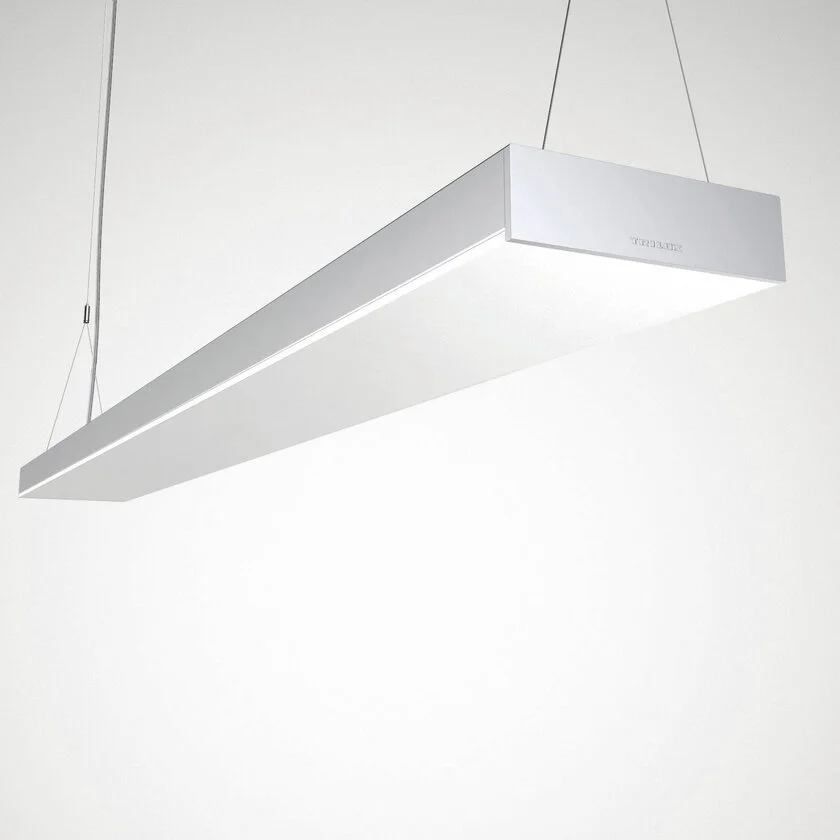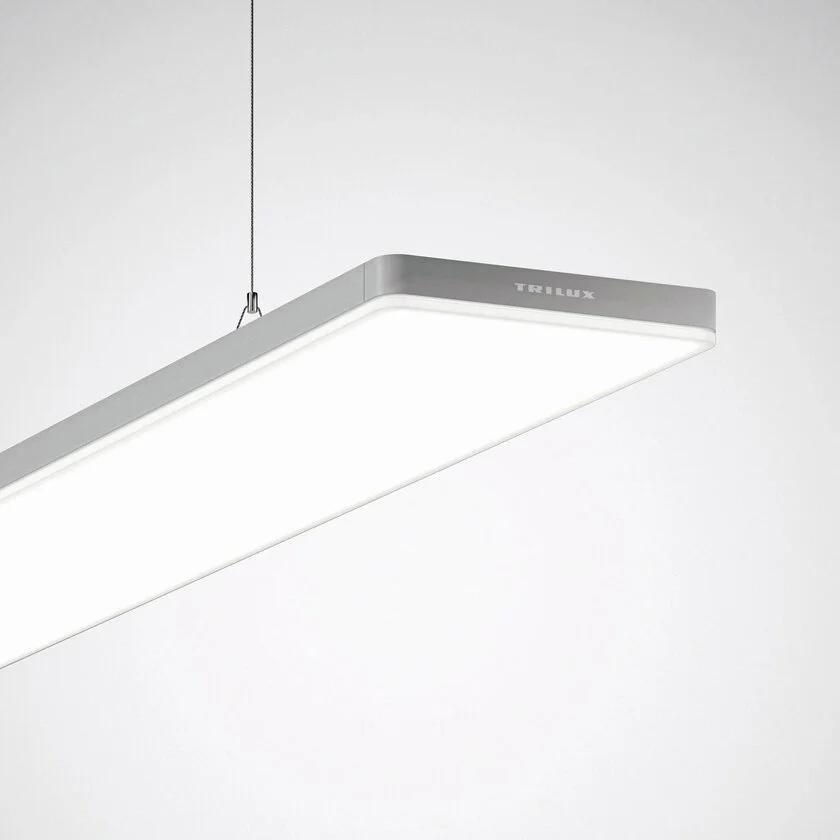Lighting for Productivity: How Smarter Workplace Lighting Supports Performance & Wellbeing
Lighting in the workplace does far more than illuminate a desk. The quality, intensity, and spectrum of light directly affect how people feel, think, and perform. Poor lighting — whether too dim, too harsh, or poorly controlled — has long been linked to fatigue, eyestrain, and even higher stress levels. But research consistently shows the opposite is also true: well-designed lighting can support alertness, boost mood, and improve productivity.
For lighting specifiers, designers, and architects, this presents both an opportunity and a responsibility: creating workplace environments where lighting actively contributes to human performance.
The science: Light, circadian rhythms, and performance
At the core of lighting’s impact on productivity is its influence on the circadian rhythm — the body’s internal 24-hour clock that regulates sleep-wake cycles, alertness, and hormonal balance. Exposure to the right kind of light at the right times helps keep this rhythm in sync, while poor lighting disrupts it.
A study by Northwestern University found that office workers with windows received 173% more white light exposure and slept an average of 46 minutes longer per night than those without windows, leading to higher vitality and better quality of life [1].
The Lighting Research Center at Rensselaer Polytechnic Institute reported that employees working under human-centric tunable lighting experienced better sleep and lower stress levels compared to those under conventional lighting [1].
Lighting that varies in intensity and colour temperature throughout the day can mimic natural daylight, reinforcing circadian entrainment. According to the National Sleep Foundation, this helps maintain alertness during the day and supports melatonin production in the evening [2].
In short, light is not just visual — it’s biological. Designing with circadian principles in mind helps employees feel sharper during the day and better rested at night.
Real-world case studies: Productivity gains through better lighting
Several organisations have already demonstrated the measurable impact of workplace lighting:
American Society of Interior Designers (Washington, D.C.)
Installed a circadian lighting protocol with 5000K lighting during the day and 2700K in the evening [1]. Outcomes included:
16% increase in productivity
19% reduction in absenteeism
25% of employees reporting improved sleep
Overall physical health scores improved
CBRE Headquarters (Amsterdam)
Implemented circadian-friendly lighting with cool, bright light in the morning and warmer tones later in the day [1] [2]. Results over seven months:
18% productivity increase
12% improvement in accuracy
76% of employees reported feeling happier
71% felt more energetic
US Federal Government Offices and Embassies
Field studies found that circadian-effective lighting significantly reduced self-reported sleepiness and increased feelings of vitality and alertness [1].
LumaStream study
Offices retrofitted with high-quality LED lighting saw an 8.3% improvement in cognitive task performance, a 33% uplift in employee mood, and a 5.76% increase in efficiency [3].
HOK design projects
Offices where employees could adjust their own lighting reported higher perceived productivity. Personal control over lighting, even simple dimming, increased comfort and focus [4].
Together, these cases highlight that workplace lighting is not just aesthetic — it delivers quantifiable returns in productivity, wellbeing, and business outcomes.
Design principles for productive workplaces
Based on research and practice, several key design strategies emerge for lighting specifiers:
Maximise daylight: Whenever possible, prioritise access to windows and natural light. Even indirect daylight improves sleep, vitality, and job satisfaction.
Use tunable white / circadian-effective lighting: Dynamic lighting systems that adjust colour temperature and intensity across the day mimic natural light and support circadian rhythms.
Prioritise LED quality: High-CRI LEDs with flicker-free drivers provide better visual comfort, reduce errors, and enhance wellbeing.
Enable personal control: Individual dimming or task lighting options improve comfort and perceived productivity.
Layer general, task, and ambient lighting: Layered lighting design reduces eye strain, adapts to multiple activities, and creates a more flexible, responsive environment.
Design for activity and atmosphere: Cooler, brighter light supports focus-intensive tasks, while warmer light fosters relaxation and collaboration.
The business case
For organisations, investing in better lighting is not just about comfort or aesthetics. It can lead to:
Higher productivity and work accuracy
Reduced absenteeism and presenteeism
Improved employee wellbeing and satisfaction
Lower energy costs and maintenance through LED and smart controls
Lighting is one of the few workplace design elements that delivers benefits for both people and performance.
Recommended products for workplace productivity
At MHL, we partner with global leaders in lighting to deliver solutions that combine energy efficiency, design flexibility, and human-centric performance. Two highly regarded products for workplace lighting are the TRILUX Lunexo and Opendo H.
TRILUX Opendo H
Strong performance, attractive design, attractive cost – Opendo LED brings high-quality planar light to education and offices.
TRILUX Lunexo H
A suspended LED luminaire with a sleek rectangular design, rounded corners, and a glowing light edge—perfect for creating innovative, prestigious office spaces.
Unios MAX
A freestanding luminaire offering direct and indirect light, adjustable colour temperature, and smart sensors—delivering comfort and effortless plug-and-play installation.
Conclusion
Workplace lighting is no longer just a background utility — it’s an active participant in how people see, feel, and perform. The research is clear: well-designed lighting can boost productivity, reduce fatigue, and improve overall wellbeing.
For specifiers and designers, the opportunity is to create office environments that don’t just look good, but help people do their best work.
If you’re planning a new workplace or upgrading an existing one, talk to MHL about lighting solutions designed to support productivity and performance.
Sources:
Four Examples: How Tunable Lighting Improved Workspace Productivity. https://blog.amerlux.com/four-examples-how-tunable-lighting-improved-workspace-productivity/
The Link Between LED Lighting and Observed Health, Learning, and Productivity. https://huntonservices.com/the-link-between-led-lighting-and-observed-health-learning-and-productivity/
How Does Lighting Improve Productivity? https://www.pecnw.com/blog/how-does-lighting-improve-productivity/
Flick of a Switch: How Lighting Affects Productivity and Mood. https://www.business.com/articles/flick-of-a-switch-how-lighting-affects-productivity-and-mood/



